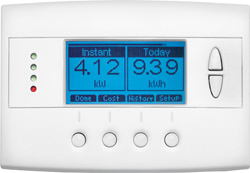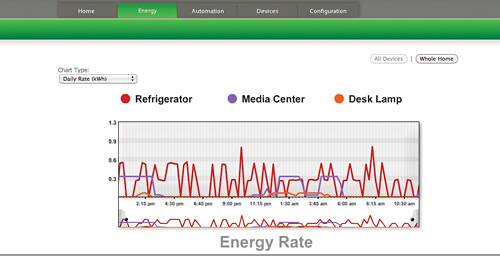Every year, power outages cost American consumers $150 billion - approximately $500 for every man, woman, and child in the United States - according to the U.S. Department of Energy). Overwhelming demand for electricity during peak hours is terribly expensive and has caused power utilities to use rolling blackouts and brownouts as a method of "load shedding."

Mary Miller
Marketing Director Z-Wave Alliance/Sigma Designs
CopperGate (A Subsidiary of Sigma Designs)

Ruth Littmann-Ashkenazi
Marketing
CopperGate (A Subsidiary of Sigma Designs)
Utilities clearly need a smarter, more practical way of managing and responding to energy demand. One potential way is the nationwide deployment of smart meters, a project costing an estimated $40-$50 billion dollars, according to the Congressional Research Service Report.
However, to realize the full potential of the smart grid, utilities need to engage consumers in a partnership that will lead to better energy management in the future. To make that possible, smart meters need a way of “speaking” with devices and appliances within the home. Without connecting energy-consuming devices to the greater Smart Grid, utilities will still be unable to manage peak demand. Utilities also recognize the importance of building good will among their customers by offering them user-friendly, in-home networking solutions that help them embrace smart energy while enjoying other lifestyle benefits of a connected home.
A fully functioning smart grid must make financial sense. Smart meters that can speak with end devices will empower consumers with information about their daily energy usage. This, in turn, will help them design ways of cutting back and saving money. Utilities will benefit by receiving information that enables them to predict energy usage, develop better pricing models, and load-shed without resorting to rolling blackouts and brownouts.
To reach these goals, the deployment of smart meters isn’t enough. Utilities need to reach people’s end devices, such as lighting systems, thermostats, and water heaters. That is ultimately where the energy demand comes from. Until now, utilities haven’t reached all the way to these end devices for three main reasons. First, there has been no single standard for communicating from the smart meter into the home. Second, the standard communications protocol used inside the home didn’t talk to the smart meter. And third, there has been a lack of interoperability that has slowed the implementation of Home Area Networks (HANs) and has raised the cost of implementation.
Smart Meter to HAN: Bridging the Gap
Achieving an affordable, practical solution to the smart grid is within the grasp of any utility. What is missing is a simple way to connect the smart meter to the consumer devices within the home. The best way to do this is by using a Home Area Network. HANs already are installed in millions of homes. All that is needed is a HAN gateway that enables a bridge between the smart meter and the end devices.
Before further discussing this bridge, it is helpful to take a glimpse within a HAN-enabled home.
Home #1 has a HAN that guarantees the resident will never enter his house in darkness. A small, light-weight fob, which attaches to a keychain, acts as a garage door opener and more. When the resident arrives home from work, he simply presses the button on this fob and the garage door opens to let him in.
The garage door opener is connected to a HAN so it is able to send command signals to other devices in the home. For instance, when the resident opens the garage door, the interior lights automatically come on. This offers the resident the security of being able to enter a home that is well lit and secure. In addition to the lights coming on, the thermostat goes into action and adjusts itself from energy saving mode to a comfortable climate setting. This entire “Arrive Home” scenario is enacted with the push of a single button – one button and the garage opens, the lights turn on and the thermostat adjusts itself.
The HAN-enabled sequence can reverse itself when the resident leaves the home for work in the morning: He closes the garage door with one button, the lights go out, and the thermostat adjusts itself again for maximum energy efficiency.
Clearly, the benefits of a HAN include energy efficiency, cost savings, and convenience for the consumer. The most widely used HAN is Z-Wave. This wireless mesh network technology is used in millions of installed devices and is built into more than 350 interoperable devices from lighting to doorlocks to thermostats and various other in-home devices – and the list is growing.
These devices enable whole-home control while also facilitating demand response by sharing energy consumption data with the consumer through energy monitors and user displays on PCs, laptops and other in-home screens. Consumption data is also shared with the smart meter. This communication link could enable utilities to load shed non-essential devices during peak hours.
One challenge for utilities, whose business models have traditionally stopped at the edge of the house, is that the home’s interior is new, frightening territory. In fact, many utilities are loath to cross the threshold because they lack experience, they worry their smart meters won’t interface with different protocols within the home, and they perceive the HAN as labor intensive, requiring the deployment of professional installers.

Thermostat doubles as in-home energy monitor
“The more utilities can get consumers to do, the better,” said Michael Kuhlmann, president of Residential Control Systems. “Utilities don’t want to be the guys to sell users all of these energy management things.”
Yet, utilities have nothing to fear. These concerns are addressed by a plug-and-play HAN that empowers the consumer. With consumer-based products, users have easy access to do-it-yourself solutions. Adding a device to a plug-and-play HAN is simple. The user simply presses a synch button on an existing device and then on the new device. Furthermore, the best HANs create a mesh (rather than point-to-point) network with no new wiring. That means, if one device falters, it doesn’t bring everything else down with it. The rest of the HAN keeps working.
Indeed, certain HANs let residents manage their home electronics from anywhere. Just about anything they can do with a remote control or an on-off switch they can now do off-site. Now let’s enter a different home – one with a HAN that enables command and control from within the home and remotely via the Internet and mobile devices…
Consider Home #2. It’s around the time the kids should be getting back from school. When they arrive, the HANenabled door locks tell the interior lights to come on and the thermostat to re-adjust to a comfortable setting. An alert is then sent to the parents’ cell phones or PCs to let them know everything is all right; the kids are safe and sound. Having this kind of control from anywhere gives consumers a new sense of confidence. It’s like being home even when they’re not.
Another important feature of a HAN is “set and forget.” This refers to the resident’s ability to create a HAN that he, himself, configures to respond in a specific way to load shedding events and demand response signals from the smart meter. Once the resident “sets” the devices, he can “forget” about the HAN and go about the business of day-to-day life. If a grid event occurs, everything will be done automatically.

For example, suppose the resident sets his lights to dim, thermostat to drop, and pool pump to cease in the event of an “orange alert signal.” When the utility issues this signal, the resident will be alerted via his mobile phone or PC. He might be asked to accept or reject the automatic load shedding and/or demand response measures. A read-out might even remind him about what he set: in this case, lights, the thermostat, and pool pump.
If he chooses accept, his smart meter will dim his lights, lower his thermostat and stop his pool pump. However, he might choose to override this response by pressing “reject,” a helpful option if, for instance, a child is home sick and needs the in-home climate to stay warm.
Home #3 is an electronic jungle. On a typical night, the kids are upstairs watching a movie, playing video games, and – just maybe – doing their homework on the computer. The wife is blow-drying her hair while bread bakes in the oven. The husband is enjoying a football game on his widescreen plasma TV in the living room.
At some point that evening, the husband decides to open the mail. He goes into sticker shock upon seeing the past month’s electricity bill and vows to cut the next month’s bill in half with the help of his HAN. Here’s how he does it:

PC-based remote management capability lets consumers control their home energy usage from anywhere in the world.
At the push of a button on his remote control, he brings up a transparent overlay at the bottom of this TV screen. This overlay tells him the real-time energy usage of every device within the home. He doesn’t even have to change the channel! While still watching the game, he’ll see how much electricity the kids are using upstairs, how much his wife is using to bake bread and blow-dry her hair, and how much he’s using to watch TV. The read-out will reveal the energy consumption of devices that no one’s using, like lights left on in the basement. These can be turned off at the push of another button on his simple HAN remote control.
Clearly HANs provide many conveniences to the end-users, and HANs that are plug-and-play and accessible from remote locations over IP and mobile phones offer the additional benefit of being easy to install and remotely accessible. Plug-and-play and remote access, however, are not the only requirements of an effective HAN. Interoperability is also vital. Different device vendors use different HAN protocols. Somehow, they all need to be able to speak to each other – and the smart meter, too.
Indeed, one of the reasons many utilities aren’t delivering on the smart grid promise is the concern about interoperability between the smart meter and the HAN. With the development of bridge devices, this issue becomes easier to solve. Utilities need a gateway that supports the smart meter and bridges to the technology that supports the HAN.
The earlier utilities are able to realize the full potential of the Smart Grid, the more quickly and effectively they will be able to manage the public’s demand for energy. They’ll also be equipped to predict energy usage in the future, when recharging electric cars and other doing other tasks that will amplify the need for better energy management.
Other benefits of implementation of the Smart Grid – from head-end to HAN – include the ability to achieve demandbased pricing models for energy. When smart meters are able to speak with end devices, utilities will be able to load shed on specific, high-consumption devices, thus sparing the need for rolling blackouts. Beyond that, the Smart Grid – when fully implemented – will bring participation and empowerment to consumers, who want to enjoy the conveniences of a connected home while keeping track of their energy usage and reducing their utility bills.
About the Authors
Mary Miller has been marketing director for Sigma Designs and the Z-Wave Alliance for nearly three years. Prior to coming to Silicon Valley she worked in consumer electronics, both in retail and on the manufacturing side. She has collaborated on nationwide consumer energy research projects and represents Sigma Designs in many of their Smart Grid and energy management initiatives, both domestically and internationally. Mary holds a BA in English from University of Louisville and has done post-graduate work at UC Berkeley.
Ruth Littmann-Ashkenazi works in marketing at CopperGate, a wholly owned subsidiary of Sigma Designs. Prior to joining CopperGate, Ruth worked for Citala, a technology company enabling flexible displays. Ruth holds a Masters in Business Administration from Boston University and a Bachelor of Arts from the University of Michigan in Ann Arbor.







